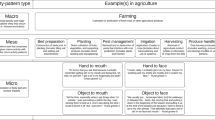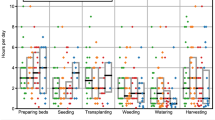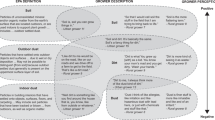Abstract
Longitudinal information on human activity patterns is required to perform reliable assessments of chronic exposure to pesticides in nonoccupational settings. As part of a longitudinal, multimedia exposure survey in Maryland, USA, we collected 2521 person-days of information on the frequency of five activities that are potentially important to pesticide exposure in residential settings: preparation of pesticides; application of pesticides; contact with soil on the skin; contact with grass on the skin; and contact with carpet. Logistic regression was used to evaluate the data for variability by time of year, day of week, and several demographic factors. Eight percent of the population reported preparing pesticides on at least one occasion over the year, while 24% of the population applied pesticides at least once. The majority of the population reported contact with soil (68%), grass (72%), and carpet (64%) over the course of a year. Skin contact with soil and grass was found to occur approximately twice as frequently (p<0.001) in spring and summer periods than in fall and winter periods. Similarly, contact with soil and grass was about 50% (p<0.05) more likely to occur on weekend days than on weekdays. These results indicate that short-term measurements (e.g., 1-day or 1-week) of these activities for an individual may not be equivalent to long-term average patterns. We also found that selected demographic characteristics were significant predictors of several of these activities. Thus, some demographic characteristics may be useful in categorizing exposure although it is unlikely that a single short-term measurement will suffice to describe annual average activity or multiple short-term activity periods.
This is a preview of subscription content, access via your institution
Access options
Subscribe to this journal
Receive 6 print issues and online access
$259.00 per year
only $43.17 per issue
Buy this article
- Purchase on Springer Link
- Instant access to full article PDF
Prices may be subject to local taxes which are calculated during checkout








Similar content being viewed by others
References
U.S. Environmental Protection Agency (EPA), Guidelines for exposure assessment. Fed Reg. (1992) 57(104). Friday, May 29 1992.
Fortmann, R. C., Sheldon, L. S., Smith, D., Perritt, K. and Camann, D. E. House Dust/Infant Pesticides Exposure Study (HIPES), Final Report. Final Report prepared for the U.S. Environmental Protection Agency under Contract Number 68-02-4544. Research Triangle Institute, Research Triangle Park, NC. RTI/4657-75/00-FR. 1991.
Garlock, T. J., Shirai, J. H. and Kissel, J. C. Adult responses to a survey of soil contact-related behaviors. J Exposure Anal Environ Epidemiol. (1999) 9(2): 134–142.
Johnson, J. E. and Kissel, J. C. Prevalence of dermal pathway dominance in risk assessment of contaminated soils — a survey of Superfund risk assessments, 1989–1992. Human Ecol Risk Assess. (1996) 2(2): 356–365.
Lewis, R. G., Fortmann, R. C. and Camann, D. E. Evaluation of methods for monitoring the potential exposure of small children to pesticides in the residential environment. Arch Environ Contam Toxicol. (1994) 26: 37–46.
MacIntosh, D. L., Kabiru, C. and Ryan, P. B. Longitudinal investigation of dietary exposure to selected pesticides. Environ Health Perspect. (2001) 109(2): 145–150.
Robinson, J. Time-diary research and human exposure assessment: some methodological considerations. Atmos Environ. (1988) 22: 2085–2092.
Robinson, J. P. and Silvers, A. Measuring potential exposure to environmental pollutants: time spent with soil and time spent outdoors. J Exposure Anal Environ Epidemiol. (2000) 10(4): 341–354.
Roberts, J. W., Budd, W. T., Ruby, M. G., Camann, D. E., Fortmann, R. C., Lewis, R. G., Wallace, L. A. and Spittler, T. M. Human exposure to pollutants in the floor dust of homes and offices. J Exposure Anal Environ Epidemiol. (1992) 2(suppl. 1): 127–146.
Ryan, P. B., Huet, N. and MacIntosh, D. L. Longitudinal investigation of exposure to arsenic, cadmium, and lead via drinking water. Environ Health Perspect. (2000) 108(8): 731–735.
Sexton, K., and Ryan, P. B. Assessment of human exposure to air pollution: methods measurements and models In: Watson A., Baters R.R., and Kennedy, D. (Eds.), Air Pollution, the Automobile, and Public Health: Research Opportunities for Quantifying Risk National Academy Press, Washington, DC. 1987.
Shealy, D. B., Barr, J. R., Ashley, D. L., Patterson, D. G., Camann, D. E. and Bond, A. E. Correlation of environmental carbaryl measurements with serum and urinary 1-naphthol measurements in a farmer applicator and his family. Environ Health Perspect. (1997) 105: 510–513.
Thatcher, T. L. and Layton, D. W. Deposition, resuspension, and penetration of particles within a residence. Atmos Environ. (1995) 29: 1487–1497.
Tomerlin, J. R., Kidwell, J. L., Tucker, J. D., Chew, S. and Lee, K. H. Dietary exposure assessment, Phase II report, Vol. 1. Development of Summary Residue Database for Dietary Exposure Assessment. Technical Assessment Systems, Inc., Washington, DC. 1993.
Tsang, A. M. and Klepeis, N. E. Results tables from a detailed analysis of the National Human Activity Pattern Survey (NHAPS) response. Draft report prepared for the U.S. Environmental Protection Agency by Lockheed Martin, Contract No. 68-W6-001, Delivery Order No. 13. (1996).
Wallace, L. A., Pellizzari, E., Hartwell, T. D., Sparacino, C., Sheldon, L. S. and Zelon, H. Personal exposures, indoor–outdoor relationships, and breath levels of toxic air pollutants measured for 355 persons in New Jersey. Atmos Environ. (1985) 19: 1651–1661.
Wallace, L. A., Pellizzari, E. D., Hartwell, T. D., Whitmore, R., Zelon, H., Perritt, R. and Sheldon, L. The California Team Study: Breath concentrations and personal exposures to 26 volatile compounds in air and drinking water of 188 residents of Los Angeles, Antioch, and Pittsburg, CA. Atmos Environ. (1988) 22: 2141–2163.
Whitmore, R. W., Kelly, J. E. and Reading, P. L. National Home and Garden Pesticide Use Survey Final Report, Vol. 1. PB92-174747. Research Triangle Institute, Research Triangle Park, NC. 1992.
Wiley, J. A. and Robinson, J. Activity patterns of California residents. Contract No. A6-177-33 with the University of California, Berkeley. California Air Resources Board, Sacramento, CA. 1991.
Wong, E. Y., Shirai, J. H., Garlock, T. J. and Kissel, J. C. Adult proxy responses to a survey of children's dermal soil contact activities. J Exposure Anal Environ Epidemiol. (2000) 10(6): 509–517.
Yess, N. J., Gunderson, E. L. and Roy, R. R. U.S. Food and Drug Administration monitoring of pesticide residues in infant foods and adult foods eaten by infants/children. J AOAC Int. (1993) 76: 492–507.
Zartarian, V. G. and Lecki, J. O. Dermal exposure: the missing link. Environ Sci Technol. (1998) 35: A134–A137.
Zartarian, V. G., Ferguson, A. C., Ong, C. G., and Leckie, J. O. Quantifying videotaped activity patterns: Video translation software and training methodologies. J Exposure Anal Environ Epidemiol. (1997) 7: 535–542.
Acknowledgements
This research was supported by the United States Environmental Protection Agency under cooperative agreement Number CR822038-1, the United States Department of Agriculture Hatch Project Number GEO00843, and the University of Georgia Research Foundation.
Author information
Authors and Affiliations
Corresponding author
Rights and permissions
About this article
Cite this article
ECHOLS, S., MACINTOSH, D. & RYAN, P. Temporal patterns of activities potentially related to pesticide exposure. J Expo Sci Environ Epidemiol 11, 389–397 (2001). https://doi.org/10.1038/sj.jea.7500179
Received:
Published:
Issue Date:
DOI: https://doi.org/10.1038/sj.jea.7500179
Keywords
This article is cited by
-
Indoor time–microenvironment–activity patterns in seven regions of Europe
Journal of Exposure Science & Environmental Epidemiology (2007)
-
Video methods in the quantification of children's exposures
Journal of Exposure Science & Environmental Epidemiology (2006)
-
Determinants of temporal variability in NHEXAS-Maryland environmental concentrations, exposures, and biomarkers
Journal of Exposure Science & Environmental Epidemiology (2005)
-
Using human activity data in exposure models: Analysis of discriminating factors
Journal of Exposure Science & Environmental Epidemiology (2003)



